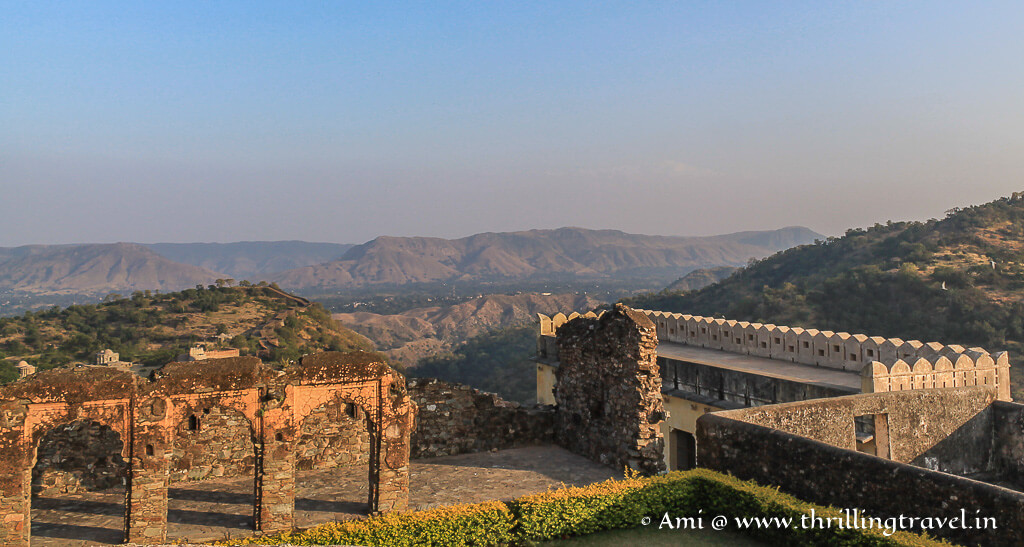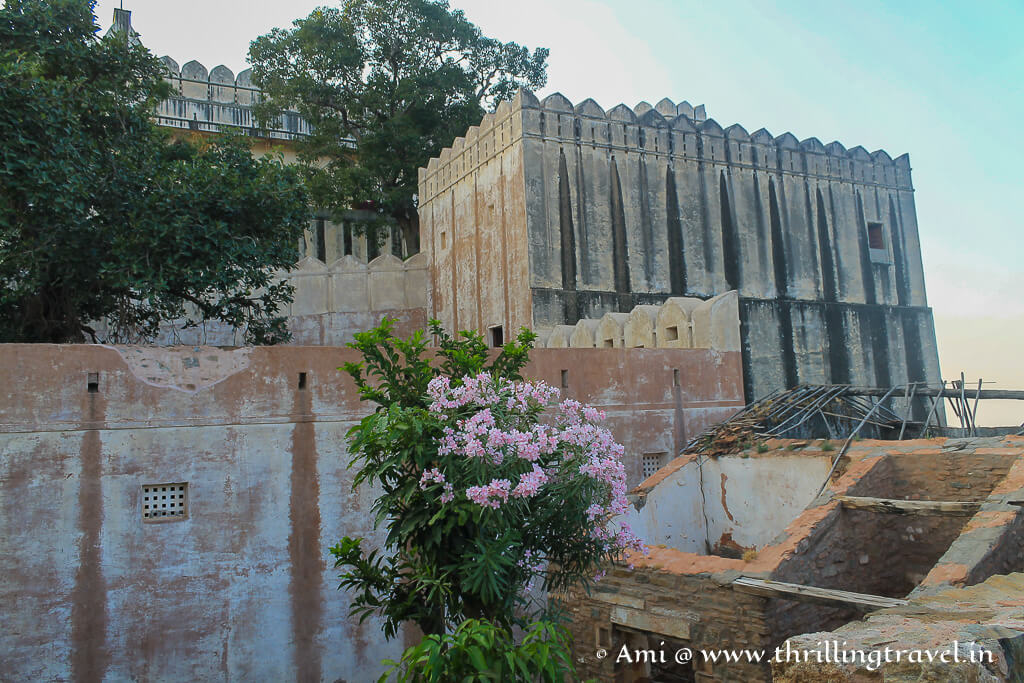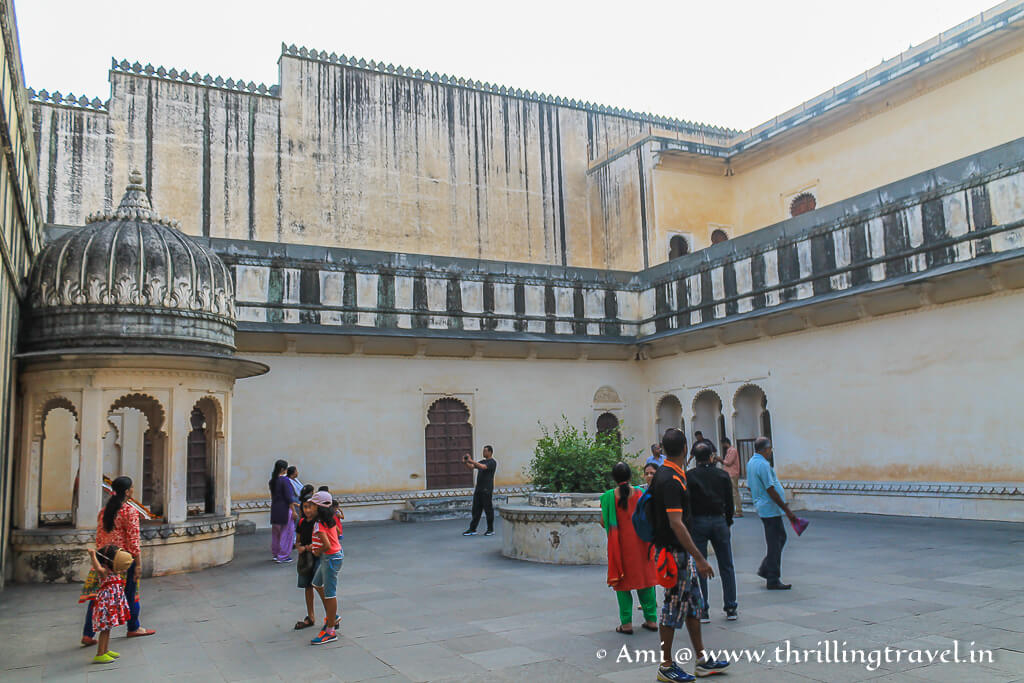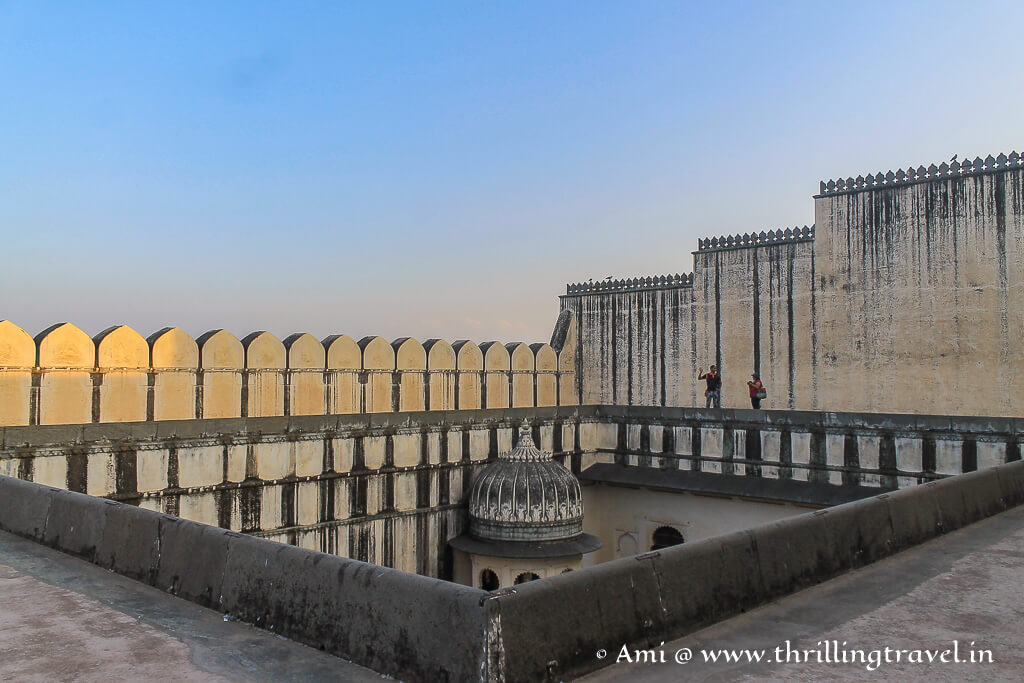[lmt-post-modified-info]
It was that hour of the day when the magic took place She ran towards the window of her beloved palace of clouds - her favorite space. Her eyes lit up as she saw the sunlight diffuse across the swirling mist Spreading an orange glow to all that it touched and kissed. These were those moments that made her Badal Mahal Kumbhalgarh a special place One that no other palace of Mewar could displace.
It is true that the sight of the second longest wall in the world at Kumbhalgarh fort had me spellbound. However, it was my visit to the enticing Badal Mahal in Kumbhalgarh fort that made me fall in love with this UNESCO World Heritage site. I had first spotted this “Palace of clouds” or Badal Mahal Kumbhalgarh from Ram Pol gate of the fort. That was enough for me to decide which part of the Great wall of India I wanted to include in this visit to Kumbhalgarh fort.

My earlier post covers the mighty walls and the structure of the Kumbhalgarh fort. It even covers the history of this fort and gives you a glimpse of all the places to visit in Kumbhalgarh fort. In that list of Kumbhalgarh sightseeing places, I have mentioned several palaces of the fort. This post is dedicated to these Kumbhalgarh palaces – Badal Mahal being my favorite among all of those. So, let’s get on with this tour of Kumbhalgarh fort.
Contents
- 1 The Kumbhalgarh Palaces
- 2 Climbing up to the Jhalia Ka Malia
- 3 Rana Kumbha Palace
- 4 Badal Mahal Kumbhalgarh
- 5 Common FAQs
- 6 What is the best way to get to Kumbhalgarh fort?
- 7 What is the best time to visit Kumbhalgarh in Rajasthan?
- 8 What are the entry fees for Kumbhalgarh fort near Udaipur?
- 9 Where can I stay in Kumbhalgarh?
- 10 What are the other places to visit in Kumbhalgarh?
- 11 Why is Badal Mahal famous?
- 12 Who built the Badal Mahal?
- 13 Travel and Photography Tips
- 14 Booking Resources
The Kumbhalgarh Palaces
There are three major Kumbhalgarh Palaces that can be visited. These include Jhalia ka Malia, Badal Mahal and Kumbha Palace. The rest of the palatial structures are in ruins. These palaces are not as ostentatious as the other Rajasthan forts like Mehrangarh fort or even the Udaipur City Palace. One of the key reasons for this could be that this fort was more of a refuge than a ruling capital. The Mewar dynasty did not really spend too much time here. However, there are significant events that happened here like the birth of Maharana Pratap. All that and more as we explore further.
Climbing up to the Jhalia Ka Malia

The climb to the palace is easy but a steep one. One needs to go through Pagara gate and follow the central cobbled path keeping Badal Mahal in your sight. Beware however – there are delights along the second largest wall in the world that will keep straying you off the path. I have shared most of these in the earlier post. Climb on till you reach this gorgeous bend and there you will spot a signboard saying “birthplace of Maharana Pratap.”
What you encounter is the first of the three main palaces of Kumbhalgarh fort – Jhalia ka Malia. This is the palace of Queen Jhali and it is in one of those rooms that Maharana Pratap was born.

The entrance to the room is through a flight of stairs along the side of the palace. The room itself seemed removed from the main palace, possibly used as an infirmary or a room where midwives were called to help out the queens. The staircase did not have any handholds and though restored, it was steep nonetheless.
Faded paintings and crumbling walls greet you in the empty room. The place did not seem like a Queen’s chamber at all and I think my earlier guess of this being a midwife’s room, was possibly true. While the room may not have anything major to talk of, the view from the room did.

From that high platform of the chamber, you can see the rest of the hills and the green cover around the fort. The golden rays of the sun make the landscape even more spectacular, so much that I spend some time here capturing a few memories from every possible angle.
Rana Kumbha Palace

The Kumbha Palace was established by the founder of Kumbhalgarh fort – Rana Kumbha itself. This part of the fort is one of the older parts and currently, is in ruins. The only functional part of this palace is its Kuldevi temple with the Akhand Deep. This temple was highly revered by the Mewar family and it is believed that none of them left the fort without seeking the blessings of their clan deity – Durga mata.
My visit to this temple was a little chilling. While exploring the ruins, I saw a few shoes left outside and religiously removed mine to go have a peep. Dark as it was, I saw one candlelight and then, something moved and beckoned me in Hindi to come in. Goosebumps erupted! But nothing to worry about, for it was an old lady, possibly the priestess in the temple room. I was a little shaken as my eyes had still not adjusted to the dark and a voice in the dark totally unnerved me.
It was the Priestess who finally explained the significance of this temple in Kumbha Mahal to me. She also, pointed to an oil lamp – the Akhand Deep that has been kept burning for the last 700 years.

The rest of the ruins consist of large halls, a kitchen area, little tunnels and small terraces. Seemed to me that these ruins were possibly homes of the help here or the kitchens for the palace.
Badal Mahal Kumbhalgarh
I think I ventured a little too long into these ruins for later, I could hear my daughter, hubby and friends shouting out for me, as they could no longer see me. :-D. I suppose they thought I fell down a rabbit hole 😉 From there on, we went ahead and climbed that staircase that opened up to what seemed the main entrance of the Badal Mahal in Kumbhalgarh Fort.

The palace is not as huge as I imagined it to be and nor as ostentatious as the Meherangarh fort of Jodhpur or the Udaipur City Palace. Simple and charming is how I would describe it.
Built by Rana Fateh Singh, the Badal Mahal clearly has two parts – the male chambers (Mardana Mahal) and the female rooms (Zenana Mahal). You can easily identify these sections from the decor – where the Zenana Mahal has a lot of jhalis or windows that would shield the women from the public eye and yet allow them to see the court proceedings. The male section is a little more colorful with their green and blue walls.

A large central courtyard connects the various rooms in a section. The entire palace is two-storied and you can see the open terraces from the central courtyard itself. I mentioned the word Simple earlier and am re-iterating it here as so far in all the palaces and forts of Rajasthan, the central courtyard had a centerpiece of architecture – be it the gorgeous doors of the Pritam Nivas Chowk of Jaipur City Palace or the Mor Chowk of the fabulous City Palace of Udaipur. I suppose, possibly because the fort was meant as a safe house, the place was devoid of such elaborate work.

While there is no major architecture or interiors to rave about, every corridor and room has some beautiful wall paintings. There is some bit of restoration work that seems to have been done as the paintings seem quite bright and fresh. The ceiling in the rooms and the doorways seem quite low that even a shortie like me had to bend my head to enter the rooms. 😉 I think that too, was by design so that the enemies if they ever reach in, would slow down.

Sadly, the rooms are not well maintained. One more unusual thing that I noticed was that the rooms were quite dark. Possibly they were used only as sleeping chambers while the terraces and corridors were used more as sitting areas. Every doorway was designed with these beautiful arches, which added charm to them.
One unusual feature of the rooms in Badal Mahal are the presence of jhali windows and the duct-styled inlet pipes. Both these facilitated ventilation – almost akin to air conditioning. The inlet allowed cool air from the bottom of the room.

There are several small narrow steps through dark corridors – some that take you to the terrace area while some connect two sections of the palace. When I say narrow, they allow only one person to pass through. The dark narrow corridors can get quite claustrophobic but for me, they were quite thrilling. Felt as if I were on an adventure trip. One has to use these corridors to access the other section of the palace. And trust me, you really don’t want to leave without having visited this section.

A central courtyard with large windows that open up to the gorgeous view of the hills and valley. It is here that I truly understood why this palace is called Palace of Clouds or Badal Mahal. Right amidst the clouds, it felt as if we were floating through the sky.
The windows have a ledge for you to perch onto and enjoy the lovely view from it. The breezy atmosphere coupled with the glow of the setting sun over the fresh green valley was enough to make this part of the palace my favorite spot, so much that my travel buddies had to literally drag me out of here.

The terrace is a different story. The view from here is spectacular. What made them adventurous was the low ledges and low railings. The connecting passages allow you to walk only in one file and the low walls do get a bit of your adrenaline pumping.You can see the railings along the sides of the terrace – these seem to be added recently. With none of them earlier, imagine how flat and boundary-less this terrace was.


I was here, right on time to see the gorgeous sunset and grab dozens of pictures to add my stack of memories. This is where I ended my tour of the Badal Mahal in Kumbhalgarh Fort. I headed back down to the entrance of the fort, with lots of lovely memories and a fair bit of wonder. I end this post now with a picture of this gorgeous sunset captured from the terrace.

In my earlier post, I took you through some astonishing facts about the Kumbhalgarh fort walls and in this part, I completed the rest of my tour by taking you to all the lovely palaces including my favorite – Badal Mahal of Kumbhalgarh. I am sure that you will be marking this as one of your must-visit places in Rajasthan. So go on, pin these and plan your trip to Kumbhalgarh Fort.
Pin This



Common FAQs
What is the best way to get to Kumbhalgarh fort?
The closest airport to Kumbhalgarh is in Udaipur. This is just 100 kms from Kumbhalgarh. From Udaipur, you can do a road trip by hiring a private cab or hopping into one of the many tourist buses and state buses.
If you are coming from any other part of India, you can also, opt for a train to Falna. This is 68 km away and from here you will have to take a private cabs or public bus to get to Kumbhalgarh.
What is the best time to visit Kumbhalgarh in Rajasthan?
In terms of season, winter is the best time to visit Kumbhalgarh. This would be from the months of October to February. Summers are extremely harsh and it is best to avoid visiting Kumbhalgarh then.
The fort opens at 9 am in the morning and closes by 6 pm. There is a light and sound show that takes place at 7 pm everyday. This is a 45 minute show that is highly recommended.
What are the entry fees for Kumbhalgarh fort near Udaipur?
The Kumbhalgarh entrance fees for Indians is INR 15, while for foreign tourists, it is INR 200. There are no camera charges. The fees for the Light and Sound show is INR 100 per person. These tickets can be booked in advance using the booking section below or you can get it at the Ram Pol gate of Kumbhalgarh fort.
Where can I stay in Kumbhalgarh?
There are plenty of Kumbhalgarh hotels and resorts that you can opt for using the Booking resources below. These include luxury resorts like Ramada and Club Mahindra as well as budget stays like Ghanerao heritage stay and Roopam resort.
What are the other places to visit in Kumbhalgarh?
Kumbhalgarh fort itself has tons of options for Kumbhalgarh sightseeing – starting with the attractions along the longest wall of India, its unique temples like Mammadev temple, Vedi temple & Golera temple and the lovely palaces like Badal Mahal. Besides this, you can visit the Kumbhalgarh Wildlife sanctuary and the Parshuram cave.
I also, recommend combining your Kumbhalgarh trip with a visit to the famous Ranakpur Jain temple and the battlegrounds of Haldighati. These are a few kilometers away from Kumbhalgarh and can be done within half a day.
Why is Badal Mahal famous?
Kumbhalgarh’s Badal Mahal is the highest point of this famous fort. The name itself means Palace of Clouds and when one visits here, they get a lovely view of the surrounding Aravalli mountains. This was the refuge residence of the Mewar Kings and though not as big or elaborate as their Udaipur palace, still is worth visiting for its vantage points. You can also, explore the pretty rooms and the central courtyards within the palace.
Who built the Badal Mahal?
Badal Mahal was built by Rana Fateh Singh. Though he resided mainly in the Udaipur City Palace, he built this new palace in his defense fort at Kumbhalgarh. It was a part of the renovation plan of this fort.
Travel and Photography Tips
- You can find a few restaurants near the fort – including one inside the fort.
- Flat shoes are highly recommend during your visit to Kumbhalgarh fort. Also, be prepared to climb stairs and inclines.
- Cotton clothes would be ideal during the day. Keep a light woolen shawl or a light jacket if you plan to be around in the evening.
- A wide lens and a regular prime lens is recommended to capture the architecture of Kumbhalgarh fort. I would not say no to a telephoto lens for the various views along the walls of Kumbhalgarh fort. If you are headed here for photography, pick early evening for the lovely sunset that you will get from Badal Mahal.
Booking Resources
- Booking.com is a good place to find hotels in Kumbhalgarh. You can use the given link to book one for yourself in Kumbhalgarh
- Klook.com offers online booking of various tours in and around Rajasthan. They even have a day tour from Udaipur to Kumbhalgarh and Ranakpur available for booking. The site also, offers fast-track tickets to the fort.
- Another online resource to book your trip to Kumbhalgarh is through GetYourGuide.
- If you use Amazon for your home and travel purchases, do consider using this link to browse and buy your requirements

Popularly referred to as a Restless Ball of Energy. My Mom refuses to entertain my complaints about my equally restless daughter & assures my husband that I was born with a travel bug.
I am a Post-Graduate in Marketing by qualification and a travel blogger by passion. Besides travel, I enjoy photography and if you don’t find me at my desk, I would be out playing badminton or swimming or just running. I believe in planning for every long weekend through the year. And when I cannot travel physically, I travel virtually through this travel blog. My travel stories have also, got published on various websites and magazines including BBC Travel, Lonely Planet India and Jetwings. I have recently published my first book – When Places Come Alive – a collection of stories that are based on legends, landscapes, art and culture of a place which is available in both ebook and paperback format.

Beautiful shots Ami 🙂
Great pics!
Thanks Anjali
Thank you Amit
Nervous moments for the group. Its sad those rooms were not maintained well. Nice pics.
Kumbhalgarh Fort in Rajasthan. Kumbhalgarh Fort is Interesting Place for a tourist. Can you suggest my how to reach Kumbhalgarh Fort.https://www.visittnt.com/india-tours/
Wow! It's such a beautiful place Ami!
Voices in the dark could be unnerving for anyone! You have now got me hooked with Kumbhalgarh!
Yep, quite sad to see that the rooms were not so well maintained. Thanks for stopping by
Hi Arjun, check out my earlier post https://thrillingtravel.in/2015/12/great-wall-of-india-kumbhalgarh.html on how to reach here. 😀
Thanks Archana
So close to you Mridula…and perfect season now. Just head there soon 😀
Nice picture…..
Thanks a ton 😀
Beautiful interiors and a great terrace from which to watch the sun. Great post.
Thanks Pramod. It is an amazing place to witness the sunset.
It looks like an absolutely enchanting place!
It sure is…Thanks for stopping by
Damn, I so regret missing our on Kumbhalgarh during my visit to Udaipur and Chittor. Looks like you had a fun time 😀 Nice Post, both parts 🙂
Thank you Vaisakhi. Am sure you will manage a visit next time you are there.
So incredibly interesting! We will definitely need to visit.
Oh you will love it. Thanks for stopping by
Wow, another stunning site! It seems that here, and other places you've highlighted, there isn't a lot of guidance for tourists and the grounds are very free flowing. Is that how tourist sites in India often are? It's so different from Western historical sites where we have queues for everything and there are guides keeping you in designated areas.
Seems like a fun place to wander around 🙂
The place looks so intriguing, wonder how it would have been in the days when it was inhabited.
Wow. The views from here look amazing!
Not true for the famous ones…which have are well regulated and have designated spots. This fort is a DYI and is not very crowded.
It sure was
Me too. Keep wondering how it would have been back then.
They sure are, especially at the time of Sunset.
The green room at Badal Mahal, Kumbhalgarh Fort is amazing. I must visit, just to see that room.
Another fabulous place of India. As always, I'm waiting impatiently to come back !
Beautiful pictures! And that view is amazing!
Thanks Alexa…am sure you will love the rest of the fort too.
🙂 Thanks Stephanie. Am sure you will enjoy this part of India too.
Thank you 😀
Stunning. The view from the windows of Badal Mahal, Kumbhalgarh Fort and the sunset over the hills of Kumbhalgarh are my favorites.
As I said, I was dragged away or I would just be sitting there taking in the views. 😀 Thanks for stopping by
How much times does it take to hike to badal Mahal from main gate and back
It’s a very short hike. A max of 15 mins.
I can see why this is a UNESCO site, there’s so much beauty and history in the fortress walls – and not 1 but 3 amazing palaces! The detailed stonework has withstood the test of time and is an incredible testemtnt to these palaces, and of all the ones you wrote about I have to agree that Badal Mahal was the most beautiful. The interior walls were really beautiful and all the little etails just special.
Thanks Jamie. You are so right. The little details is what makes this place special
Wow I didn’t realize there was so much more to this fort than just the wall. Incredible palaces and architecture — what an amazing place to visit!
Oh yes, those palaces and temples is what makes this long wall different. Thanks for stopping by Tami
Wow, what a gorgeous place to visit and the views are stunning! The window ledges seem a bit scary especially if you leaned out too far.
True that, those windows do make you miss a heart beat. Thanks Debra
I can see why it got its name of Palace of the clouds. What a heavenly place. It looks so majestic and tranquil with so many photo ops! It’s too bad the interior wasn’t maintained, but with it being declared a UNESCO a site, it will be protected for years to come.
Thanks Renee for stopping by. The walls and the exteriors are pretty well preserved. Hopefully now the interiors will get a face lift.
All I can say, the views from the Kumbhalgarrh Fort is breathtaking, as well as from the other two ruins! I wonder if women sent to Jhalia ma Kamalia to give birth. I will probably a bit shaky when taking picture by the window perch though.
Thanks Umiko. Generally, women were sent to a separate birthing room. I guess in this palace this was it.
So strategic of it to be on top of a hill which paves the way for stunning views and spectacular shots! The Hindu-Muslim mixed architecture is beautiful. It’s truly important for the kids to visit so they know about amazing place.
Thanks Trisha. I have always taken my daughter with me on family holidays. It does get them to see things differently.
Visiting the Badal Mahal at Kumbhalgarh Fort seems to be a fantastic adventure. Fort looks fabulous, and the views are breathtaking. Great to know that it is a UNESCO World Heritage site. The view from the room where Maharana Pratap was born is stunning. As Rajasthan is still on my top list of places in India to visit – I hope to see it one day. Great tips for trip planning!
Thanks Agnes. There is no missing Rajasthan and when you do plan, don’t forget Kumbhalgarh. It is close to Udaipur, so easily doable.
Whoa! I didn’t know that the world’s 2nd longest wall after the Great Wall of China is here in India. Thanks for this detailed write up. The room where Maharana Pratap was born? Wow, I’d definitely want to visit here. The view from the Queen’s room is indeed exceptional! Your visit to the Kuldevi temple is definitely interesting. Good that you reached the terrace right on time for sunset.
Thanks Bhushavali. I loved this place and am glad I went here. So many astonishing facts abt this palace.
Too bad they we were not able to maintain the rooms well. However, I still think it’s worth the visit. Thank you for sharing your experience. If I also met the priestess, I’d have goosebumps too.
Plenty to see around the rooms.So frankly, I did not mind them. Thanks for stopping by, Clarice